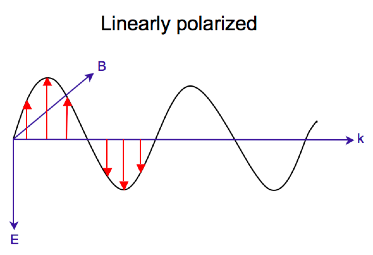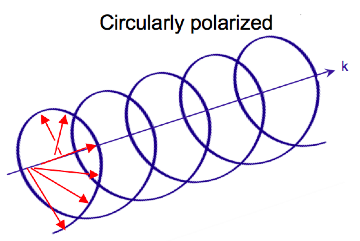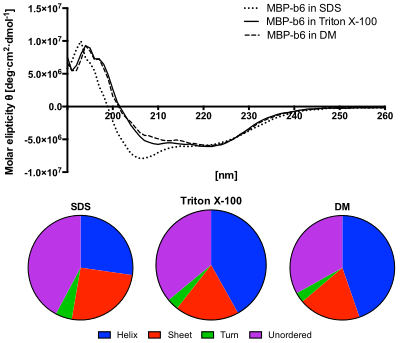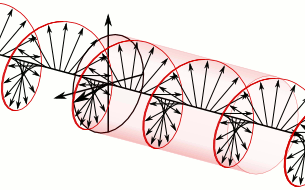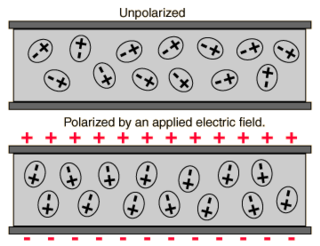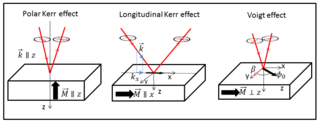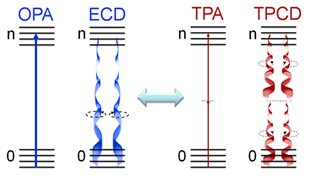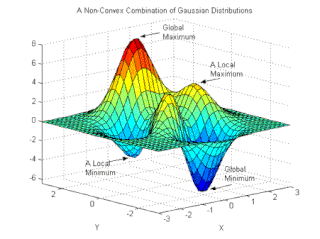Physical principles
Circular polarization of light
Electromagnetic radiation consists of an electric and magnetic field that oscillate perpendicular to one another and to the propagating direction, [7] a transverse wave. While linearly polarized light occurs when the electric field vector oscillates only in one plane, circularly polarized light occurs when the direction of the electric field vector rotates about its propagation direction while the vector retains constant magnitude. At a single point in space, the circularly polarized-vector will trace out a circle over one period of the wave frequency, hence the name. The two diagrams below show the electric field vectors of linearly and circularly polarized light, at one moment of time, for a range of positions; the plot of the circularly polarized electric vector forms a helix along the direction of propagation . For left circularly polarized light (LCP) with propagation towards the observer, the electric vector rotates counterclockwise. [2] For right circularly polarized light (RCP), the electric vector rotates clockwise.
Interaction of circularly polarized light with matter
When circularly polarized light passes through an absorbing optically active medium, the speeds between right and left polarizations differ () as well as their wavelength() and the extent to which they are absorbed (). Circular dichroism is the difference . [5] The electric field of a light beam causes a linear displacement of charge when interacting with a molecule (electric dipole), whereas its magnetic field causes a circulation of charge (magnetic dipole). These two motions combined cause an excitation of an electron in a helical motion, which includes translation and rotation and their associated operators. The experimentally determined relationship between the rotational strength of a sample and the is given by
The rotational strength has also been determined theoretically,
We see from these two equations that in order to have non-zero , the electric and magnetic dipole moment operators ( and ) must transform as the same irreducible representation. and are the only point groups where this can occur, making only chiral molecules CD active.
Simply put, since circularly polarized light itself is "chiral", it interacts differently with chiral molecules. That is, the two types of circularly polarized light are absorbed to different extents. In a CD experiment, equal amounts of left and right circularly polarized light of a selected wavelength are alternately radiated into a (chiral) sample. One of the two polarizations is absorbed more than the other one, and this wavelength-dependent difference of absorption is measured, yielding the CD spectrum of the sample. Due to the interaction with the molecule, the electric field vector of the light traces out an elliptical path after passing through the sample.
It is important that the chirality of the molecule can be conformational rather than structural. That is, for instance, a protein molecule with a helical secondary structure can have a CD that changes with changes in the conformation.
Delta absorbance
By definition,
where (Delta Absorbance) is the difference between absorbance of left circularly polarized (LCP) and right circularly polarized (RCP) light (this is what is usually measured). is a function of wavelength, so for a measurement to be meaningful the wavelength at which it was performed must be known.
Molar circular dichroism
It can also be expressed, by applying Beer's law, as:
where
- and are the molar extinction coefficients for LCP and RCP light,
- is the molar concentration,
- is the path length in centimeters (cm).
Then
is the molar circular dichroism. This intrinsic property is what is usually meant by the circular dichroism of the substance. Since is a function of wavelength, a molar circular dichroism value () must specify the wavelength at which it is valid.
Extrinsic effects on circular dichroism
In many practical applications of circular dichroism (CD), as discussed below, the measured CD is not simply an intrinsic property of the molecule, but rather depends on the molecular conformation. In such a case the CD may also be a function of temperature, concentration, and the chemical environment, including solvents. In this case the reported CD value must also specify these other relevant factors in order to be meaningful.
In ordered structures lacking two-fold rotational symmetry, optical activity, [8] [9] including differential transmission [10] (and reflection [11] ) of circularly polarized waves also depends on the propagation direction through the material. In this case, so-called extrinsic 3d chirality is associated with the mutual orientation of light beam and structure.
Molar ellipticity
Although is usually measured, for historical reasons most measurements are reported in degrees of ellipticity. Molar ellipticity is circular dichroism corrected for concentration. Molar circular dichroism and molar ellipticity, , are readily interconverted by the equation:

This relationship is derived by defining the ellipticity of the polarization as:
where
- and are the magnitudes of the electric field vectors of the right-circularly and left-circularly polarized light, respectively.
When equals (when there is no difference in the absorbance of right- and left-circular polarized light), is 0° and the light is linearly polarized. When either or is equal to zero (when there is complete absorbance of the circular polarized light in one direction), is 45° and the light is circularly polarized.
Generally, the circular dichroism effect is small, so is small and can be approximated as in radians. Since the intensity or irradiance, , of light is proportional to the square of the electric-field vector, the ellipticity becomes:
Then by substituting for I using Beer's law in natural logarithm form:
The ellipticity can now be written as:
Since , this expression can be approximated by expanding the exponentials in a Taylor series to first-order and then discarding terms of in comparison with unity and converting from radians to degrees:
The linear dependence of solute concentration and pathlength is removed by defining molar ellipticity as,
Then combining the last two expression with Beer's law, molar ellipticity becomes:
The units of molar ellipticity are historically (deg·cm2/dmol). To calculate molar ellipticity, the sample concentration (g/L), cell pathlength (cm), and the molecular weight (g/mol) must be known.
If the sample is a protein, the mean residue weight (average molecular weight of the amino acid residues it contains) is often used in place of the molecular weight, essentially treating the protein as a solution of amino acids. Using mean residue ellipticity facilitates comparing the CD of proteins of different molecular weight; use of this normalized CD is important in studies of protein structure.
Mean residue ellipticity
Methods for estimating secondary structure in polymers, proteins and polypeptides in particular, often require that the measured molar ellipticity spectrum be converted to a normalized value, specifically a value independent of the polymer length. Mean residue ellipticity is used for this purpose; it is simply the measured molar ellipticity of the molecule divided by the number of monomer units (residues) in the molecule.



